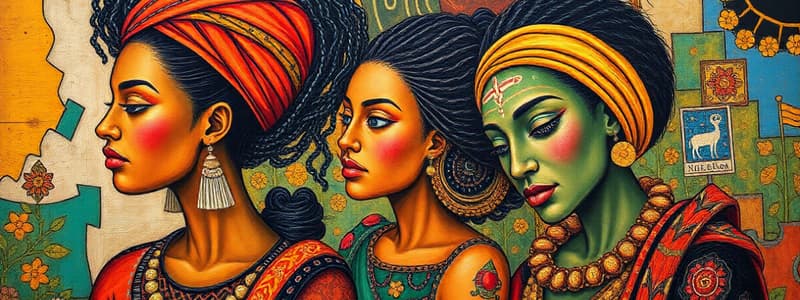Podcast
Questions and Answers
What aspect of art education does the content suggest has experienced dominance despite claims of multiculturalism?
What aspect of art education does the content suggest has experienced dominance despite claims of multiculturalism?
- Local art traditions
- Indigenous craftsmanship
- Informal art practices
- Western aesthetic canons (correct)
What stereotype does geographic determinism support according to the content?
What stereotype does geographic determinism support according to the content?
- The noble savage (correct)
- The industrious immigrant
- The wise elder
- The talented local artist
Which author is noted for advocating the theory of geographic determinism?
Which author is noted for advocating the theory of geographic determinism?
- Isaac Edwards Clarke
- Marsden
- Leclerc (correct)
- Popkin
What did Isaac Edwards Clarke assert about the future of civilization during the Centennial Exposition?
What did Isaac Edwards Clarke assert about the future of civilization during the Centennial Exposition?
According to the content, what geographic area is suggested to produce the most beautiful people?
According to the content, what geographic area is suggested to produce the most beautiful people?
What has conditioned many educators' views regarding the production of great art?
What has conditioned many educators' views regarding the production of great art?
Which assumption about art is considered a culture-bound assumption that needs to be challenged?
Which assumption about art is considered a culture-bound assumption that needs to be challenged?
What does ethnocentrism often imply in the context of racism?
What does ethnocentrism often imply in the context of racism?
Which of the following is a challenge faced by art education in a multicultural society?
Which of the following is a challenge faced by art education in a multicultural society?
According to Garcia’s assertion, what should educators do to address issues of racism and prejudice?
According to Garcia’s assertion, what should educators do to address issues of racism and prejudice?
What impact does a Eurocentric perspective have on art education?
What impact does a Eurocentric perspective have on art education?
Which of the following is NOT considered a typical cultural assumption about great art?
Which of the following is NOT considered a typical cultural assumption about great art?
What was the primary focus of Zerffi's Manual of the Historical Development of Art?
What was the primary focus of Zerffi's Manual of the Historical Development of Art?
Which of the following best describes the nature of Zerffi's beliefs regarding race?
Which of the following best describes the nature of Zerffi's beliefs regarding race?
Who was the director of the Art Training School that Zerffi dedicated his manual to?
Who was the director of the Art Training School that Zerffi dedicated his manual to?
Which statement reflects the essence of racism as identified by Marsden?
Which statement reflects the essence of racism as identified by Marsden?
What influenced Zerffi's views about art, despite his claims otherwise?
What influenced Zerffi's views about art, despite his claims otherwise?
Which of the following was a common source of misconceptions about race during the Victorian era?
Which of the following was a common source of misconceptions about race during the Victorian era?
What aspect of Zerffi's commentary on 'the Negro' exemplifies Victorian racial attitudes?
What aspect of Zerffi's commentary on 'the Negro' exemplifies Victorian racial attitudes?
What was one effect of scientific developments prior to 1900 regarding racial attitudes?
What was one effect of scientific developments prior to 1900 regarding racial attitudes?
In what context did Zerffi's analysis of art take place?
In what context did Zerffi's analysis of art take place?
What common flaw in scientific discussions of race is highlighted by the historical context provided?
What common flaw in scientific discussions of race is highlighted by the historical context provided?
What was one major basis for judging non-white individuals according to the content?
What was one major basis for judging non-white individuals according to the content?
What was the policy of the Houston Museum of Fine Arts regarding black visitors during the 1930s?
What was the policy of the Houston Museum of Fine Arts regarding black visitors during the 1930s?
Who is credited with being the first to classify various races according to the content?
Who is credited with being the first to classify various races according to the content?
According to Zerffi, what is lacking in the artistic abilities of the racial group he refers to as 'Turanian'?
According to Zerffi, what is lacking in the artistic abilities of the racial group he refers to as 'Turanian'?
Zerffi describes the art of which race as the 'crowning product of the cosmical forces of nature'?
Zerffi describes the art of which race as the 'crowning product of the cosmical forces of nature'?
What stereotype of black peoples was introduced to European and American readers through certain popular books?
What stereotype of black peoples was introduced to European and American readers through certain popular books?
How did David Hume describe the contributions of non-white individuals?
How did David Hume describe the contributions of non-white individuals?
What does Zerffi suggest about the relationship between art and bodily construction?
What does Zerffi suggest about the relationship between art and bodily construction?
Which group was also viewed with suspicion according to the content?
Which group was also viewed with suspicion according to the content?
What was one of the effects of the intertwined nature of racism and power, as stated in the content?
What was one of the effects of the intertwined nature of racism and power, as stated in the content?
What influence did craniometry have on the thinking in art education?
What influence did craniometry have on the thinking in art education?
What concept does the statement about blacks being seen as inferior viewers of art reinforce?
What concept does the statement about blacks being seen as inferior viewers of art reinforce?
Which of the following best describes Zerffi's view on artistic development among different races?
Which of the following best describes Zerffi's view on artistic development among different races?
What was a common assumption about the talents of the 'low white' individuals mentioned?
What was a common assumption about the talents of the 'low white' individuals mentioned?
What kind of art does Zerffi suggest is unknown to the 'Turanian' racial group?
What kind of art does Zerffi suggest is unknown to the 'Turanian' racial group?
Which time period is characterized by the beginning of Western aesthetics according to the content?
Which time period is characterized by the beginning of Western aesthetics according to the content?
What generalization was made regarding the characteristics of white individuals in the content?
What generalization was made regarding the characteristics of white individuals in the content?
In which context were statements about racial superiority and artistic ability often made?
In which context were statements about racial superiority and artistic ability often made?
What does Zerffi imply about the Negro in the context of artistic perception?
What does Zerffi imply about the Negro in the context of artistic perception?
Flashcards
Eurocentric Art
Eurocentric Art
The belief that European art is the most important and influential art form in the world.
Art and Craft Hierarchy
Art and Craft Hierarchy
The idea that fine art, like painting and sculpture, is superior to craft, like pottery or weaving.
Male Dominance in Art
Male Dominance in Art
The historical bias that prioritizes art created by men over art created by women.
Individual Genius Myth
Individual Genius Myth
Signup and view all the flashcards
Formalist Aesthetics
Formalist Aesthetics
Signup and view all the flashcards
Ethnocentrism
Ethnocentrism
Signup and view all the flashcards
Multicultural Art Education
Multicultural Art Education
Signup and view all the flashcards
Geographic Determinism
Geographic Determinism
Signup and view all the flashcards
Noble Savage
Noble Savage
Signup and view all the flashcards
Lazy Native
Lazy Native
Signup and view all the flashcards
Climate and Physical Traits
Climate and Physical Traits
Signup and view all the flashcards
Protestant White Races
Protestant White Races
Signup and view all the flashcards
Racial Exclusion in Museums
Racial Exclusion in Museums
Signup and view all the flashcards
Imitation vs. Originality
Imitation vs. Originality
Signup and view all the flashcards
Cranial Capacity and Art
Cranial Capacity and Art
Signup and view all the flashcards
Artistic Development Stages
Artistic Development Stages
Signup and view all the flashcards
Fear of Change
Fear of Change
Signup and view all the flashcards
Racism and Hegemony
Racism and Hegemony
Signup and view all the flashcards
Normalization of Oppression
Normalization of Oppression
Signup and view all the flashcards
Art as a Tool of Control
Art as a Tool of Control
Signup and view all the flashcards
The Impact of Eurocentrism
The Impact of Eurocentrism
Signup and view all the flashcards
Craniometric Analysis
Craniometric Analysis
Signup and view all the flashcards
Victorian Racial Attitudes
Victorian Racial Attitudes
Signup and view all the flashcards
What did Zerffi believe about 'The Negro'?
What did Zerffi believe about 'The Negro'?
Signup and view all the flashcards
Poynter's Artistic Tradition
Poynter's Artistic Tradition
Signup and view all the flashcards
How did Zerffi support Poynter's tradition?
How did Zerffi support Poynter's tradition?
Signup and view all the flashcards
Race and Art
Race and Art
Signup and view all the flashcards
Social Significance of Race
Social Significance of Race
Signup and view all the flashcards
Influence of Victorian Society on Science
Influence of Victorian Society on Science
Signup and view all the flashcards
Scientific Validation of Prejudice
Scientific Validation of Prejudice
Signup and view all the flashcards
The Impact of Everyday Prejudice
The Impact of Everyday Prejudice
Signup and view all the flashcards
David Hume's Argument
David Hume's Argument
Signup and view all the flashcards
Linnaeus's Racial Classification
Linnaeus's Racial Classification
Signup and view all the flashcards
Impact of Racial Hierarchies
Impact of Racial Hierarchies
Signup and view all the flashcards
Stereotypes of Black People
Stereotypes of Black People
Signup and view all the flashcards
Craniometry
Craniometry
Signup and view all the flashcards
Art and Craft Distinction
Art and Craft Distinction
Signup and view all the flashcards
Elitist Aesthetics
Elitist Aesthetics
Signup and view all the flashcards
Western Bias in Aesthetics
Western Bias in Aesthetics
Signup and view all the flashcards
Artistic Representations
Artistic Representations
Signup and view all the flashcards
Study Notes
Ethno- and Egocentrism in Art Curriculum
-
Elitist and prejudiced understandings of art originate from biased notions of race and gender—primarily that Western European males created all great art.
-
Eurocentric notions and theories, both biblical and pseudoscientific, have influenced art education.
-
Art education must acknowledge that art is not just European- it must recognize the cultures of diverse people.
-
Those in power disproportionately value their own art forms over others.
-
Western art curricula often prioritize European art canons.
-
Some art educators have criticized these practices for being Eurocentric, culture-bound, elitist and racist.
-
These criticisms note biases in historical art evaluation and exclusion of diverse artistic perspectives.
-
Arguments have been made about the importance of providing multicultural curricula that give visibility to diverse artistic traditions.
-
There are claims that current art curricula and art educational beliefs are ethnocentric.
Culture-Bound Assumptions About Art
- The best art is believed to have been produced by Europeans.
- Specific art forms from Europe (oil painting, sculptures, monumental architecture) are deemed superior.
- A hierarchy exists between art and craft, with art often placed above craft.
- The best art is predominantly male.
- Art judgments focus on traits like composition, color and media use and ignore sociocultural context.
- Individual genius and aesthetic response are prioritized above sociocultural meaning.
Ethnocentrism and Racism
- Arguments favoring slavery, colonialism, racial disparities, and gender roles have been associated with scientific reasoning.
- Ethnocentrism implies implicit racism by evaluating other cultures based on one's own cultural background.
- Some art educators have argued that European historical art standards often privilege Western cultural attributes over others.
- Nineteenth-century art education often presented non-Western art as inferior or childish.
- Artwork produced by people of color has often been stereotyped and minimized, overlooking their unique cultural context.
- Western art educators have historically disregarded the arts of other cultures.
Recapitulation Theory and Racial Hierarchy
- The notion that non-Western art is childish or undeveloped, mirroring a developmental stage in the creation of Western art.
- Some theorists believe that non-European cultures reflect an inferior stage of artistic progression compared to Western art traditions.
- The belief in a racial hierarchy, where Western culture was deemed superior, directly impacted art education.
- People who adhered to this belief often overlooked or belittled art produced by non-Western cultures.
Cultural Prejudice and Art Education
- Ethnocentric biases persist in current art education practices.
- Some art education practices still prioritize Western art canons over other artistic traditions.
- Multicultural approaches have had limited success in challenging Eurocentric bias in art education.
- Art educators must acknowledge historical prejudices and adapt their curricula accordingly.
- Art education should prioritize the representation and study of diverse artistic traditions.
Studying That Suits You
Use AI to generate personalized quizzes and flashcards to suit your learning preferences.




